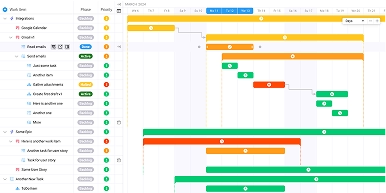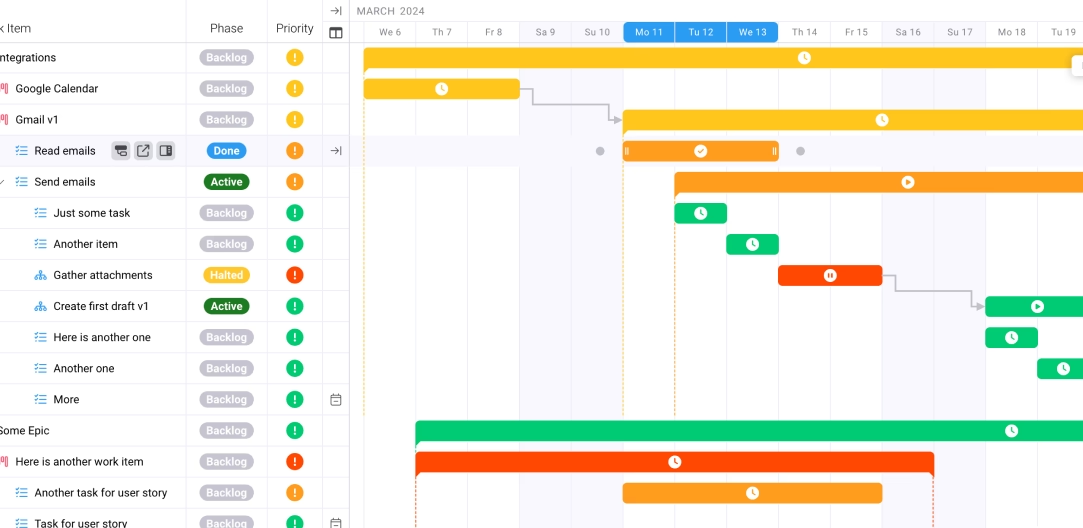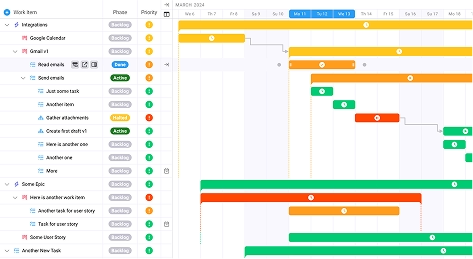
Demonstrate Project Value: How to Prove ROI at Every Stage of the Project Lifecycle
Key takeaways:
Projects fail not because they lack technical merit, but because stakeholders never see their value. A recent survey found that organizations with structured cost-benefit analysis frameworks demonstrate 42% higher project success rates. Yet most project managers struggle to demonstrate project value consistently throughout execution. The ability to prove ROI isn't just about final numbers—it's about creating a continuous narrative of value that keeps stakeholders engaged and ensures projects receive the resources they need to succeed.
The Value Measurement Challenge
Traditional project management focused primarily on the triple constraint: scope, schedule, and budget. While these metrics remain important, they tell an incomplete story. A project can finish on time and under budget yet fail to deliver meaningful business value.
This disconnect creates significant problems. Without clear value demonstration, projects lose stakeholder support mid-execution, face resource constraints, or get cancelled despite strong potential. The Project Management Institute's research shows that only one in five organizations report having a high level of benefits realization maturity, though this represents a 63% increase from 2013 levels.
The real issue is timing. Most organizations only evaluate project value at two points: during initial approval and after completion. This leaves a dangerous gap during execution when stakeholder confidence can erode and competing priorities can derail progress.
A Framework for Continuous Value Demonstration
Effective value demonstration requires a systematic approach that spans the entire project lifecycle. The most successful organizations build value measurement into every phase, creating a continuous feedback loop that keeps all stakeholders aligned.
Phase 1: Initiation and Business Case Development
The foundation for demonstrating project value starts during initiation. This is where you establish the baseline metrics and expected benefits that will guide all future value assessments.
Build a Quantifiable Business Case
Return on Investment (ROI) is calculated by taking the actual or estimated income from a project and subtracting the actual or estimated costs. That number represents the total profit that a project has generated or is expected to generate. The basic formula is:
ROI = [(Financial Value - Project Cost) / Project Cost] x 100
However, the best business cases go beyond this simple calculation. They include:
- Multiple value metrics: Financial returns, efficiency gains, risk reduction, strategic positioning
- Time-based projections: When benefits will be realized, not just their total value
- Baseline measurements: Current state metrics that you'll compare against future results
- Assumptions documentation: Clear statements about what must remain true for benefits to materialize
Organizations serious about benefits realization need to document how benefits are being measured as well as capture the assumptions behind value estimates.
Identify All Stakeholder Value Drivers
Different stakeholders care about different aspects of value. Executives focus on strategic alignment and financial returns. Operations leaders prioritize efficiency and risk reduction. End users value usability and productivity improvements.
During initiation, map each stakeholder group to their primary value drivers. This allows you to tailor your value communications throughout the project, ensuring everyone sees the benefits that matter most to them.
Create Your Benefits Realization Plan
A Benefits Realization Plan documents the activities necessary for achieving planned benefits, identifies a timeline, and defines the tools and resources necessary to ensure benefits are fully realized over time. This plan should include:
- Specific benefits and how each will be achieved
- Metrics and KPIs for measuring progress
- Roles and responsibilities for benefits management
- Timeline for when benefits will materialize
- Risk assessments for each anticipated benefit
Phase 2: Planning for Value Tracking
Once your project receives approval, the planning phase is your opportunity to build value measurement into your project structure.
Establish Leading and Lagging Indicators
Leading indicators predict future performance and provide early signals of potential issues, while lagging indicators reflect past performance and show whether project goals have been met. Your value tracking system needs both.
Leading indicators for value might include:
- Stakeholder engagement levels
- Early adoption rates in pilot programs
- Process efficiency improvements during development
- Risk mitigation progress
Lagging indicators include:
- Actual cost savings realized
- Revenue increases attributed to the project
- Productivity improvements measured post-implementation
- Customer satisfaction scores
Build Value Checkpoints into Your Schedule
Rather than waiting until project completion, schedule regular value assessment points. Many organizations conduct quick business case reviews at each major milestone or gate review. This allows portfolio governance teams to take appropriate action if project value has deteriorated.
These checkpoints should include:
- Revalidation of business case assumptions
- Assessment of changing market conditions
- Review of benefits timeline
- Adjustment of value projections based on current data
Select the Right KPIs
Modern project management demands a deeper understanding of whether initiatives are truly delivering value, whether resources are being optimized, and whether stakeholders are satisfied. When selecting KPIs for value demonstration, follow these principles:
- Make them SMART (Specific, Measurable, Achievable, Relevant, Time-bound)
- Align them directly with strategic objectives
- Include both financial and non-financial metrics
- Ensure they can be tracked throughout project execution
- Limit yourself to 5-8 core value KPIs to maintain focus
Essential KPIs for value demonstration include:
- Cost Performance Index (CPI): Ratio of earned value to actual costs
- Schedule Performance Index (SPI): Ratio of earned value to planned value
- Benefits Realization Rate: Percentage of expected benefits actually delivered
- Stakeholder Satisfaction Score: Regular assessment of key stakeholder confidence
- Return on Investment (ROI): Both projected and actual as data becomes available
Phase 3: Execution and Real-Time Value Communication
During execution, your ability to demonstrate project value becomes critical. This is when competing priorities emerge, resources get constrained, and stakeholder attention wanes.
Implement Continuous Value Monitoring
Using project management tools with dashboards helps track and report progress effectively. Real-time monitoring allows you to:
- Identify value erosion early
- Make data-driven decisions about trade-offs
- Provide immediate updates to stakeholders
- Adjust tactics without losing sight of overall value goals
Create Value-Focused Status Reports
Traditional status reports focus on tasks completed and schedule adherence. Value-focused reports tell a different story. They should include:
- Progress toward benefits realization, not just task completion
- Early wins and quick value demonstrations
- Trending of key value metrics over time
- Risks to value realization and mitigation strategies
- Comparison of actual vs. projected value trajectory
Celebrate and Communicate Early Wins
Don't wait until project completion to demonstrate value. Recognizing and appreciating achievements along the way not only bolsters morale but also reinforces positive behaviors.
Identify opportunities for early value demonstration:
- Pilot programs that show immediate benefits
- Process improvements that generate quick savings
- Risk events avoided through proactive management
- Capability improvements that enhance team productivity
Share these wins broadly with all stakeholder groups, tailoring the message to what each group values most.
Use Data Visualization Effectively
Numbers alone rarely tell a compelling story. Project management dashboards provide a customized view where you can analyze your most important product metrics on one screen.
Effective visualizations for value demonstration include:
- Value realization curves showing projected vs. actual benefit delivery
- Cost-benefit trending over time
- Risk heat maps highlighting threats to value
- Stakeholder satisfaction trending
- Comparison charts showing performance against benchmarks
Phase 4: Monitoring, Control, and Value Optimization
As projects progress, conditions change. Market shifts, organizational priorities evolve, and new opportunities emerge. The monitoring and control phase is where you adapt your value demonstration to these realities.
Conduct Regular Value Assessments
Organizations should have metrics to measure performance and allocate resources more efficiently. Schedule formal value assessment sessions monthly or quarterly, depending on project duration.
These sessions should address:
- Are our original value assumptions still valid?
- Have new value opportunities emerged?
- What external factors might impact our benefits realization?
- Do we need to adjust our benefits timeline?
- Should we pivot our approach to maximize value?
Manage Value Risks Proactively
Benefits realization helps mitigate risks by providing a clear way to identify and address potential issues early in the project lifecycle. Create a value risk register that tracks:
- Threats to anticipated benefits
- Probability and impact of value erosion
- Mitigation strategies for each risk
- Owner responsible for each risk response
- Monitoring triggers that indicate risk is materializing
Optimize Resource Allocation for Maximum Value
As you gather data during execution, you may discover that some project elements deliver disproportionate value while others underperform. This allows project managers to prioritize projects based on their potential to deliver the highest value.
Use your value data to make informed decisions about:
- Where to invest additional resources
- Which features or capabilities to prioritize
- What scope elements might be candidates for descoping
- Whether to accelerate or delay specific components
Phase 5: Closure and Benefits Transition
Project closure is where many value demonstration efforts fail. The project team disbands, attention moves elsewhere, and no one tracks whether anticipated benefits actually materialize.
Create a Comprehensive Value Report
Your project closeout should include a detailed value report that documents:
- All value metrics from project initiation through completion
- Comparison of projected vs. actual benefits (to date)
- Benefits still in progress or not yet realized
- Lessons learned about value estimation and tracking
- Recommendations for future value management
Execute a Benefits Transition Plan
The program or project manager prepares a benefits transition plan with active involvement from stakeholders who are the benefit recipients. This ensures benefits continue to be realized after the project team disperses.
The transition plan should address:
- Who owns each benefit going forward
- How benefits will continue to be measured
- What resources or support are needed for sustainment
- Timeline for full benefits realization
- Escalation paths if benefits don't materialize as expected
Schedule Post-Implementation Value Reviews
Many benefits don't fully materialize until months or even years after project completion. Schedule post-implementation reviews at appropriate intervals (typically 3, 6, and 12 months post-closure) to:
- Validate that expected benefits are being realized
- Identify any unexpected benefits or challenges
- Capture additional lessons learned
- Adjust operations if benefits are underperforming
- Celebrate success when benefits exceed expectations
Advanced Strategies for Value Demonstration
Beyond the phase-by-phase approach, several advanced strategies can enhance your value demonstration capabilities.
Implement Benefits Realization Management
Benefits Realization Management (BRM) ensures that you carry out the most effective projects and focuses on maximizing project value within the larger organization. BRM is an enterprise-level approach that:
- Aligns all projects with strategic objectives
- Creates accountability for benefits delivery
- Provides consistent methodologies across the portfolio
- Ensures learning from one project informs future initiatives
Organizations with mature BRM practices consistently achieve better project outcomes and higher stakeholder satisfaction.
Use Portfolio-Level Value Tracking
Individual project ROI matters, but portfolio-level value tracking provides even more powerful insights. Portfolio management software provides charts and dashboards to help track portfolio value.
Portfolio-level tracking enables:
- Identification of which project types deliver the highest value
- Recognition of patterns in value realization
- Better resource allocation across the portfolio
- Strategic decision-making about future investments
Adopt Predictive Analytics
AI-assisted tools analyze historical project data to generate more precise ROI predictions and learn from past performance to calibrate future estimations. Predictive analytics can:
- Identify correlations between early indicators and final outcomes
- Forecast value realization more accurately
- Highlight projects at risk of underperforming
- Suggest optimization strategies based on similar past projects
Create a Value Communication Plan
Different stakeholders need different information at different frequencies. Create a formal value communication plan that specifies:
- What value information each stakeholder group receives
- How frequently they receive updates
- What format works best for each audience
- Who is responsible for each communication
- How stakeholders can access detailed value data on demand
Measuring What Matters: Key Value Metrics
While every project is unique, certain value metrics consistently prove most useful for demonstrating ROI.
Financial Metrics
- Net Present Value (NPV): The current value of all cash inflows and outflows related to an investment over its life, using a given discount rate
- Payback Period: Time required to recover the initial investment
- Cost Savings: Direct reductions in operational or capital expenses
- Revenue Impact: Increases in sales or market share attributable to the project
- Total Cost of Ownership (TCO): Full cost including implementation and ongoing operations
Operational Metrics
- Efficiency Gains: Percentage improvement in process speed or resource utilization
- Quality Improvements: Reduction in defects, rework, or customer complaints
- Productivity Increases: Output per employee or per hour worked
- Cycle Time Reduction: Faster time to market or time to delivery
- Capacity Enhancement: Increased ability to handle volume without proportional cost increase
Strategic Metrics
- Market Position: Share gains or competitive advantages achieved
- Risk Reduction: Quantified decrease in business risks
- Strategic Alignment: Degree to which project supports organizational objectives
- Innovation Enablement: New capabilities that enable future opportunities
- Customer Experience: Improvements in satisfaction, loyalty, or Net Promoter Score
Stakeholder Metrics
- Stakeholder Satisfaction: Regular surveys or assessments of key stakeholders
- Change Adoption: Percentage of target users actively using new capabilities
- Employee Engagement: Team morale and commitment throughout the project
- Customer Feedback: Direct input from those impacted by the project
Common Pitfalls in Value Demonstration
Even with solid processes, organizations often stumble in demonstrating project value. Avoid these common mistakes:
Waiting Too Long to Show Value
Don't save all value demonstration for project completion. Stakeholders need regular reinforcement that their investment is paying off. Look for opportunities to demonstrate value throughout execution.
Focusing Solely on Financial ROI
While financial returns matter, they're not the only form of value. Strategic positioning, risk reduction, capability enhancement, and customer satisfaction all represent genuine value that may not show up immediately in financial statements.
Ignoring Non-Financial Benefits
Many organizations find that the ability to determine whether project benefits have come from the work undertaken or whether they would have happened anyway is often inconsistent. Establish clear baselines and measurement approaches for non-financial benefits.
Failing to Adjust Projections
Markets change, organizations evolve, and assumptions prove incorrect. Rigidly sticking to original value projections even when conditions change undermines credibility. Update your value forecasts based on current realities.
Not Assigning Benefit Ownership
Without a Business Value Owner, no one has direct responsibility for overseeing benefit realization, and benefits will be left to chance. Assign clear ownership for each anticipated benefit.
Overlooking Value Sustainment
Benefits realized during project execution can erode over time without proper sustainment. Plan for how benefits will be maintained and enhanced after project closure.
Building Organizational Capabilities
Demonstrating project value effectively requires more than good project management—it requires organizational capabilities and culture.
Develop Value-Focused Project Managers
Traditional project management training emphasizes delivery of scope on time and budget. Modern project managers need additional skills in:
- Benefits identification and quantification
- Stakeholder value mapping
- Financial analysis and business case development
- Data analysis and visualization
- Strategic communication
Create Standards and Templates
Organizations excel at value demonstration when they have standardized approaches. Develop organizational standards for:
- Business case formats and required content
- Benefits realization plans
- Value tracking dashboards
- Status reporting that includes value metrics
- Post-implementation review processes
Tools like Ravetree provide centralized platforms for tracking projects, collecting value data, and measuring outcomes across your entire portfolio.
Foster a Culture of Value
The most successful organizations make value demonstration part of their culture. This means:
- Celebrating value achievements, not just deliverables
- Making value data transparent and accessible
- Rewarding teams that exceed value targets
- Learning from projects that underdeliver value
- Encouraging honest discussion about value challenges
Looking Ahead: The Future of Value Demonstration
Value demonstration continues to evolve with new technologies and methodologies.
AI and Predictive Value Analytics
Smart KPIs powered by artificial intelligence become sources—not merely measures—of strategic differentiation and value creation. AI systems can:
- Predict value outcomes with greater accuracy
- Identify hidden patterns in value realization
- Recommend optimization strategies in real-time
- Alert stakeholders to value risks before they materialize
Continuous Value Measurement
Traditional periodic ROI assessment is giving way to continuous monitoring approaches. Real-time value tracking will become standard, allowing immediate course corrections.
Integrated Business Planning
Value demonstration is increasingly integrated with broader business planning processes. Projects aren't evaluated in isolation but as part of holistic portfolio and strategic planning that considers interdependencies and cumulative effects.
Conclusion
The ability to demonstrate project value at every stage of the project lifecycle isn't just a nice-to-have skill—it's essential for project success in modern organizations. Stakeholders invest resources based on expected value, continue support based on demonstrated value, and judge success based on realized value.
By building value measurement into each phase from initiation through closure and sustainment, you create a continuous narrative that keeps stakeholders engaged and ensures your projects receive the support they need. The framework provided here—establishing clear metrics during initiation, building tracking mechanisms in planning, communicating progress during execution, optimizing during monitoring and control, and transitioning benefits at closure—provides a comprehensive approach to demonstrate project value consistently.
Organizations that master this capability don't just deliver more successful projects. They build stronger stakeholder relationships, make better investment decisions, and create lasting business impact. They transform project management from a focus on activities and deliverables to a focus on value creation and strategic contribution.
When you demonstrate project value effectively throughout the project lifecycle, you don't just prove ROI—you create it.
Frequently Asked Questions
Q: How early should I start demonstrating project value?A: Value demonstration begins during project initiation when you develop the business case. Establish clear value metrics and baselines before the project starts so you can track progress from day one.
Q: What's the difference between ROI and value demonstration?A: ROI is typically a single financial metric calculated at the end of a project. Value demonstration is a continuous process that encompasses financial ROI plus strategic, operational, and stakeholder value throughout the project lifecycle.
Q: How often should I provide value updates to stakeholders?A: Frequency depends on project duration and stakeholder needs. Most projects benefit from brief value updates in every status report and detailed value reviews at major milestones or monthly/quarterly intervals.
Q: What if early metrics show the project isn't delivering expected value?A: This is exactly why continuous value tracking matters. Early warning allows you to investigate root causes, adjust your approach, reset expectations, or even recommend project termination if value can't be realized.
Q: How do I measure non-financial value?A: Establish clear metrics for strategic, operational, and stakeholder benefits during planning. Use surveys, productivity measurements, adoption rates, risk assessments, and other quantitative approaches to track non-financial value objectively.
Q: Who should own value tracking and reporting?A: The project manager leads value demonstration, but specific benefits should have designated owners who are accountable for their realization. A Business Value Owner at the organizational level often oversees the overall benefits strategy.
Q: How long after project closure should we continue measuring value?A: Many benefits take 6-18 months to fully materialize. Schedule post-implementation reviews at 3, 6, and 12 months minimum. For strategic projects, continue tracking key metrics for 2-3 years.









